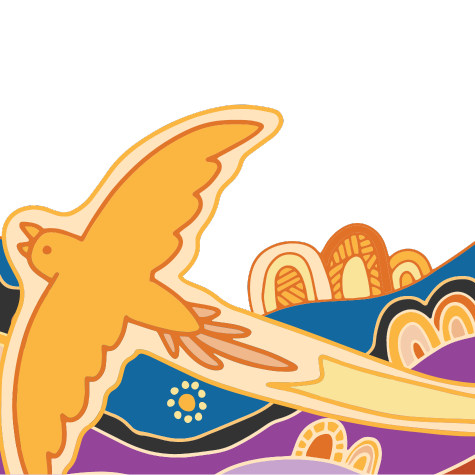Aiming to encourage those interacting with Pearson Schools' digital platforms to connect with Aboriginal and Torres Strait Islander arts and culture, the artwork above was created by Aboriginal artist Samantha Campbell to accompany our Acknowledgement of Country. It shows a Kookaburra flying across country, with the hills and waterholes below. You will find the full image of this illustration across Pearson Schools digital platforms, including at the bottom of all Pearson Schools web pages.
Schools are in the privileged position of guiding the next generation of Australians to shape their own ideas, beliefs and values. This makes them a wonderful place to celebrate significant events like NAIDOC Week, by allocating class time to learn about the history, culture and achievements of Aboriginal and Torres Strait Islander peoples. The way teachers do this depends on factors such as the students’ year level, but the overarching goal is the same: helping young learners develop knowledge of and respect for Aboriginal and Torres Strait Islander peoples’ culture and achievements.
What is NAIDOC Week?
NAIDOC (which stands for National Aboriginals’ and Islanders’ Day Observance Committee) Week is an event held across Australia in the first week of July each year (Sunday to Sunday), that celebrates the history, culture and achievements of Aboriginal and Torres Strait Islander peoples. It provides an opportunity for people living in Australia to support and get to know our local Aboriginal and Torres Strait Islander communities through activities and events held across the country.
Some activities include listening to Aboriginal and Torres Strait Islander Australian music, hearing Creation stories, and connecting with culture through art. Art and storytelling are essential to Aboriginal and Torres Strait Islander culture. Exploring these artistic expressions during NAIDOC Week can help people of all backgrounds appreciate the beauty, intricacy and richness of Aboriginal and Torres Strait Islander art forms and encourage celebration of the history, culture and achievements of Aboriginal and Torres Strait Islander peoples year-round, beyond NAIDOC week.
The 2024 theme is ‘Keep the Fire Burning! Blak, Loud and Proud’. The National NAIDOC Committee selected this theme ‘to celebrate not only the survival but also the relentless spirit of Aboriginal and Torres Strait Islander communities. “Keep the Fire Burning!” is a nod to the vitality and endurance of culture, and a nod to connection with Country and community, while “Blak, Loud and Proud” represents an unapologetic celebration of identity.’
The Evolution of NAIDOC Week
NAIDOC Week has its roots in the 1938 Day of Mourning. The Day of Mourning took place on Australia Day in 1938 when the Australian Aborigines Progressive Association (AAPA) and many Aboriginal people made a substantial impact on the national conversation in a civil rights movement involving a march through the streets of Sydney and a congress of over a thousand people. A culmination of many years’ work from the AAPA, it would become a centrepiece of Aboriginal and Torres Strait Islander activism throughout the remainder of the 20th century.
Why NAIDOC Week Is An Important Reflection Point for Australian Educators
NAIDOC Week is an important time for all people living in Australia to reflect on how they can celebrate Aboriginal and Torres Strait Islander history, culture and achievements.
Teachers wanting to build confidence leading these celebrations can refer to the NAIDOC Week website where there are many resources and support materials available. Teachers can use these and other sources to do their own learning, finding the activities that best connect with them and their students to make the week as positive as possible.
With NAIDOC Week now more prevalent in media, students will likely have some familiarity, which may help teachers feel more comfortable holding these conversations and being open to learn alongside their students. For every year level, there are different activities to engage students to help build an appreciation and knowledge of Aboriginal and Torres Strait Islander history, culture and achievements.

NAIDOC Week for Early Childhood
This year’s NAIDOC Week theme seeks to enable childhood and early primary educators to create a safe and expansive space for young children to imagine a freedom of spirit and Country. By fostering this environment, it can set students up from a young age to ‘create collective yarning circles around a fire, sharing Aboriginal stories, songs, dance, knowledge and wisdom.’
An example of an activity teachers can guide young students through, is a ‘campfire/yarning circle.’ Children can bring something to be a part of the circle, such as a gift from nature, and they can make a fire area either inside or outside using classroom props. This can be used as a space to bring in story, song, dance or shared art. Teachers can guide their students to add handprints or footprints to a big sheet of paper to make a class mural. Children can add messages, drawings, paintings and collage ideas to form the igniting of fire, and spend time together exploring and learning about Aboriginal and Torres Strait Islander history and knowledge.
NAIDOC Week for Primary Students
For primary students, educators can begin to explore the history and achievements of Aboriginal and Torres Strait Islander peoples by including the study of prominent historical figures in the curriculum. In honour of the Elders and senior Aboriginal and Torres Strait Islander peoples who have paved the way, educators are encouraged to explore short biographies with their class. While reading through these stories, it helps to prepare discussion questions to guide conversations about how each individual kept their morale high and values resolute, and how Aboriginal and Torres Strait Islander peoples advocated for change across the country.
This aims to teach students not only the history of Country, but also to help instil a sense of responsibility and leadership. It can help NAIDOC Week forge long-term involvement and celebration of the history, culture and achievements of Aboriginal and Torres Strait Islander peoples by primary students, in an effort to build a strong and authentic care for reconciliation.

NAIDOC Week for Secondary Students
NAIDOC Week is an opportunity for educators to guide secondary students to complete their schooling as informed and empathetic young adults. Whatever personal and career path they pursue, learning about Aboriginal and Torres Strait Islander culture can help young adults respect and appreciate all cultures and histories, leaving a significant impact on the person they become. While the government protocol for teaching Aboriginal and Torres Strait Islander culture differs between states, there is consensus that teachers should help students engage respectfully with the culture through learning and celebration.
Secondary students are at an appropriate age to discuss Aboriginal and Torres Strait Islander history and culture in terms of colonialism, imperialism, and cultural preservation. There are different ways for educators to open these conversations. Teachers can invite local Aboriginal and Torres Strait Islander leaders and change-makers in the school community to share their experiences and the actions they have taken to create change and advocate for Aboriginal and Torres Strait Islander peoples. Students can research inspiring Aboriginal and Torres Strait Islander leaders and share what they feel makes them inspiring with the class. These activities can be done any time, not just during NAIDOC Week, however as a nationally observed celebration, it provides a helpful reflection point for educators and students to pause, discuss and learn.
NAIDOC Week for the Next Generation
NAIDOC Week aspires to help build a better future for the next generation by encouraging Australians to engage authentically with Aboriginal and Torres Strait Islander culture. While each year has a different theme to help people connect to the culture, the aim is always to help Aboriginal and Torres Strait Islander peoples’ feel their issues are deeply considered in the future of the country, to continue building a long-term commitment that goes beyond NAIDOC Week.
— NAIDOC Committee, 2024
Schools are in a privileged position to help young Australians shape their own ideas, beliefs and values. The celebration of NAIDOC Week is an important part of Australia’s culture and history and incorporating it into education is a worthy endeavour for teachers, students and communities for the present and future.

